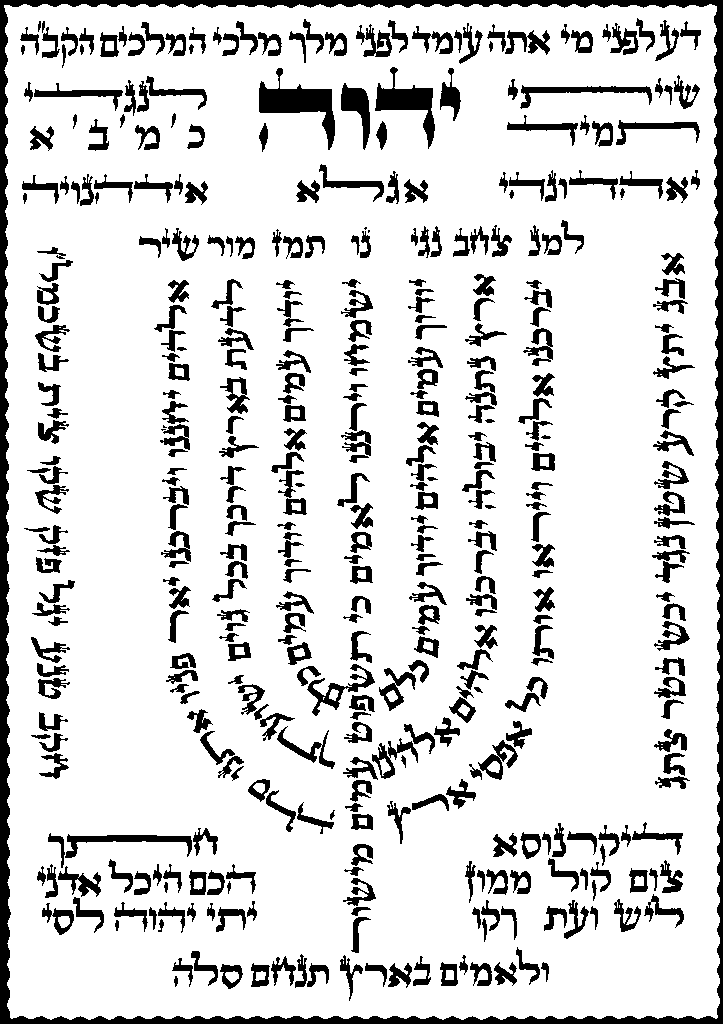Many overlook the depth behind the daily recitation of the Mizmorim Mizmor LeTodah and Yehi Kavod in the morning prayers.
These Psalms (145-150) are not mere poetic additions but they are rooted in halachic and spiritual foundations that connect us directly to Divine service. Based on the Zohar, the Arizal explains that these Mizmorim help us elevate the sparks of holiness of that specific day throughout the chambers of the world of Yetzirah.
This is their division:
Mizmor 145 (Ashrei) – no elevation yet (maybe a preparation?)
Mizmor 146 – Heichal (chamber of) Malkhut
Mizmor 147 – Heichal Yesod until the verse “לא בגבורת האיש…״”, from them until the end it’s Heichal Netzach and Hod
Mizmor 148 – Heichal Tiferet until just before the very last verse, which is the Heichal Gevurah
Mizmor 149 – Heichal Chesed
Mizmor 150 – Heichal Keter, Chokhmah, Binah and Da’at
The Shulchan Aruch (Orach Chaim 51:9) rules explicitly that Mizmor LeTodah should be recited with joy and melody, reflecting the spirit of gratitude it expresses. Song does have incredible power to elevate the prayer.
The Korban Todah, which this Psalm parallels, was offered in the Temple by one who survived danger or was shown a clear act of Divine kindness (see Vayikra 7:12, Berachot 54b). This offering included forty loaves and had to be eaten in a single day, symbolizing an overwhelming outpour of thanks to Hashem.
The lesson is clear: if we truly recognized the privilege of serving Hashem, we would say Mizmor LeTodah with the joy of Yosef HaTzaddik, who remained spiritually vibrant even in exile, dancing every day (there’s a Midrash about how he danced through the streets of Egypt). This heartfelt expression of thanks is not just emotionally uplifting; it actually helps remove spiritual blockages and sweetens judgment, as taught by many Mekubalim.

The Transformative Power of the Mizmorim with Joyful Gratitude
The Baal Shem Tov emphasized that serving Hashem with joy is not merely an emotional state but a spiritual imperative. In Tzava’at HaRivash (§111), we learn that through joy, one can cleave to Hashem, fulfilling the verse, “To love Hashem, your God, to follow in all His ways, and to adhere to Him” (Deuteronomy 11:22). This adherence is achieved by increasing our energy frequency as we all know, and joy is a key component in this spiritual emulation.
The Midrash (Vayikra Rabbah 9:7) states that in the future, all sacrifices will be nullified except for the thanksgiving offering (Korban Todah). We can surmise that this reflects the perpetual relevance of gratitude in our relationship with Hashem. And yes, Hashem owes us nothing, though we can certainly count on his compassion for everything but this will be the subject of another article.
Either way, by continuing to recite the mizmorim of shacharit, we maintain a timeless connection to this enduring form of worship. It serves as a daily reminder of the importance of acknowledging and appreciating the continuous benevolence bestowed upon us by the Divine.
The Enduring Power of Gratitude
The Midrash Vayikra Rabbah 9:7 teaches that in the future, all sacrifices will be nullified except the Korban Todah, which will never be abolished. Gratitude is eternal. As our sages teach in Massechet Brachot, our prayers today are spiritual replacements for sacrifices. Saying Mizmor LeTodah with intent is akin to offering a Korban Todah, activating channels of abundance and protection. Same goes for all mizmorim.
The structure of the mizmorim themselves hints at the centrality of this Psalm. From Ashrei (Psalm 145) to the last five Hallelu-kah Psalms (146–150), the sequence is unified and climactic. Mizmor LeTodah (Psalm 100) precedes this final arc, serving as the gateway to elevation. In Kabbalistic terms, it’s the vessel that channels the divine flow awakened by Baruch She’amar, rooted in the Thirteen Attributes of Mercy and when we start the elevation through the world of Yetzirah.
When we recite Mizmor LeTodah, we are not only thanking Hashem for the evident blessings but also for the hidden ones. This practice cultivates a mindset of constant gratitude, reinforcing our bond with the Creator and enhancing our spiritual awareness.
The Menorah Meditation: Lamenatzeach
In many Siddurim, Psalm 67 (Lamenatzeach) is written in the shape of a Menorah. This is based on the tradition from the Arizal, who taught that this arrangement contains powerful spiritual energy. The central verse (“Yoducha amim Elokim…”) represents the central branch of the Menorah, while the other verses form the branches on either side.
Though some versions begin on the right side (in keeping with Hebrew writing norms), the tradition according to the Arizal (Sha’ar HaKavanot, Derushei HaTefillah) places the first verse on the left. The order reflects a deeper spiritual symmetry, not just aesthetic layout. The Roshei Teivot (initial letters) and Sofei Teivot (final letters) of the verses form various Divine Names that are intended for meditation and kavvanah.
Even if your Siddur lacks the visual Menorah format, you can picture it mentally. This visualization is not symbolic alone but it is a vessel to draw Light and harmonize the seven lower sefirot, just like the Menorah of the Temple represented. You can also write the Heichalot (chambers) in the pages of the mizmorim as cited in the list above.

Sweetening Judgments through Prayer and Deed
We also learned in many other articles that life’s difficulties often stem from spiritual judgments.
Our collective soul’s rectification during the 6000 years of Creation is to repair the damage caused by Adam’s sin, which introduced harshness and concealment into the world (see Etz Chaim, Sha’ar Adam Kadmon). Every person must engage in sweetening these judgments, not only through suffering but by using specific spiritual tools.
One striking example is the Maror eaten at the Pessach Seder. The Ari (Pri Etz Chaim, Sha’ar Pesach) explains that Maror has the same gematria as mavet (death). By eating it with kavanah and dipping it into sweet Charoset, we symbolically transform bitterness into sweetness. This is not just symbolic, but a deep spiritual practice to convert judgment into mercy.
Song, dancing and clapping all accomplish the same thing, as Rebbe Nachman taught in many places. These are highly recommended when a person is beset by difficulties (chas v’shalom).
Pidyon and the Power of Tzedakah
Another method for sweetening decrees is through Pidyon Nefesh or Pidyon Kaparot, a form of spiritual redemption where money is given to charity to offset potential harm. We also find in the Zohar that dam (blood) is tied to mammon (money), as both represent life force. By giving money in place of blood, one draws Divine mercy and fulfills the decree to “shed blood”.
Our Sages teach in Bava Kamma 119a that stealing money is like stealing a person’s life. This further emphasizes how money represents effort, time, and essence. Giving tzedakah, especially in moments of tension or danger, can avert harsh decrees and bring about tremendous healing.
You can find more about Pidyon HaNefesh and the power of Tzedakah here.
Conclusion: Cultivating a Daily Practice of Joyful Awareness
In this article we saw many different forms of sweetening the judgments. Ideally one should start at Chatzot HaLaylah (Midnight) or at least praying Shacharit with proper kavanah especially during the Mizmorim.
Whether through Mizmor LeTodah, visualizing the Menorah in Lamenatzeach, or giving charity with intention, our daily practices carry powerful potential for change and blessings. They are all rooted in performing Mitzvot and prayer with joy.
Gratitude and intentionality align us with God’s divine flow of light and prepare the world for redemption. Don’t let these moments pass unnoticed.
Engage with them, rejoice in them, and use them to rebuild your inner sanctuary.







